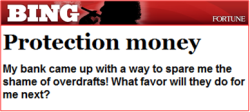 Protection money, the latest While You Were Out column, is yet another Stanley Bing masterpiece that explains why I open the FORTUNE magazine from its last page – Bing’s permanent abode. In this article, Bing – who cheekily clarifies that he has no connection with Microsoft’s latest search engine – blends form and content that are diametrically opposed to each other to weigh in on overdraft protection, which is the current hot topic in the US banking industry.
Protection money, the latest While You Were Out column, is yet another Stanley Bing masterpiece that explains why I open the FORTUNE magazine from its last page – Bing’s permanent abode. In this article, Bing – who cheekily clarifies that he has no connection with Microsoft’s latest search engine – blends form and content that are diametrically opposed to each other to weigh in on overdraft protection, which is the current hot topic in the US banking industry.
The uninitiated might wonder why there’s such a heated debate around this topic if they read Bing’s definition of overdraft protection: “No matter what you spend with your debit card, even if you have no money in your account, the guys at the bank will make sure that you’re not embarrassed. They’ll pay your tab!”. Whereas people who’re tuned in to this debate know that banks are doing this not as a magnanimous gesture but in return for the 25-35 dollars they charge each time their customers overdraw their checking accounts.
Interestingly, you can portray banks as saviors or villains depending upon how the concept of overdraft protection is projected. By not declining your telephone bill payment transaction when your account didn’t have enough money to cover your bill, your bank makes sure that you’re not slapped costly penalties and reinstatement charges by your telephone company. By charging only $35 in ovedraft protection fee for this favor, your bank does appear to be your savior. But, as in the oft-cited example, when your bank charges you $35 in fee when your $4 coffee busted your bank balance, it comes across as a villain.
Let me add a few more angles to this issue and leave it to you to decide whether ovedraft protection is an example of “genuine protection”, a case of “protection money” or a cry for “over with protection”.
[polldaddy poll=2231006]
Saviors or villains, there’s increasing realization that banks cannot extend overdraft protection for free. British banks made this clear during a similar furore in the UK around two years ago. American banks are following suit now. So, the crux of the current debate is really about how much they can charge for it and at what point they should inform their customers about it.
The consumer rights protection camp in the US is insisting that banks must extend overdraft protection only when customers request for it explicitly and then, do so at cost. In other words, they want banks to stop enrolling customers for overdraft protection programs by default and making them into a source of profits.
If banks are coerced – by consumers, regulators, or both – to price overdraft protection fee at cost, we can expect a renewed debate over the true cost. While the most obvious component of the cost is related to additional staffing required to handle overdraft, there could be other hidden costs viz. risk premium. When a bank approves an overdraft, it’s taking a credit risk and might insist that its risk premium cost is included in determining the overall cost of providing overdraft protection.
Pingback: Overdraft Opt-In Presents A Huge Opportunity For BPOs « Talk of Many Things